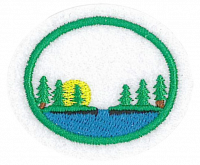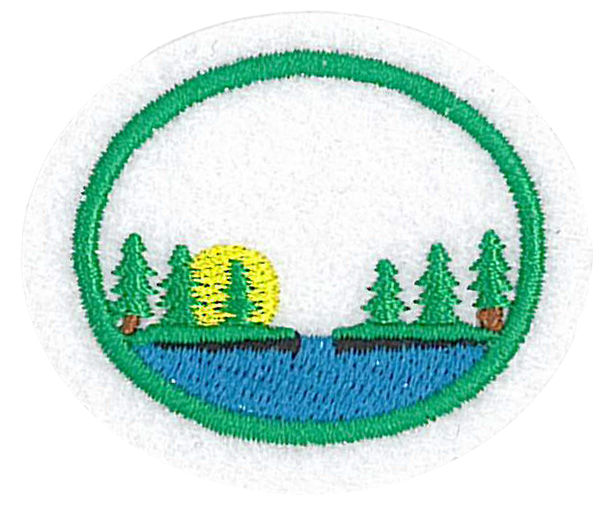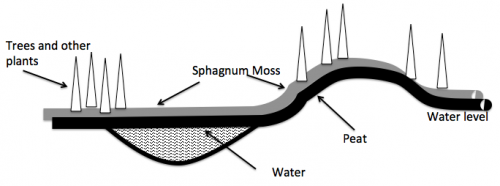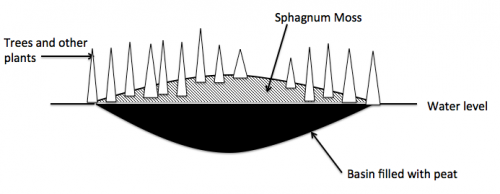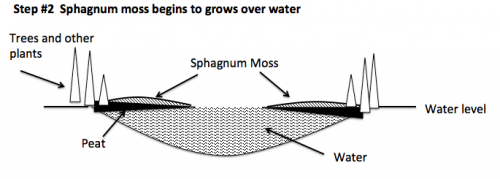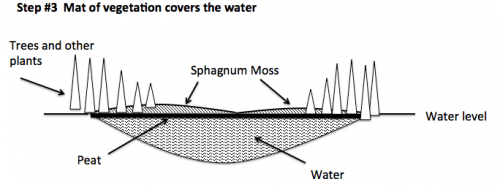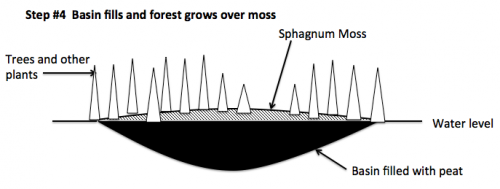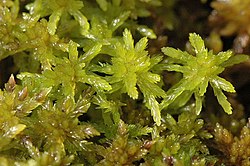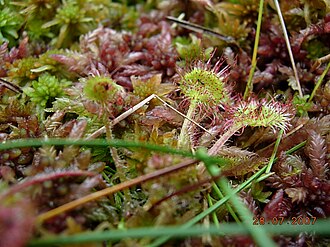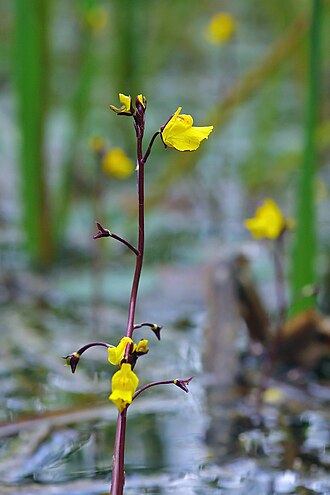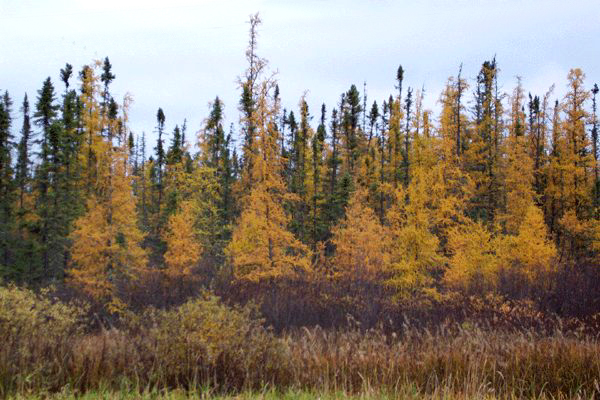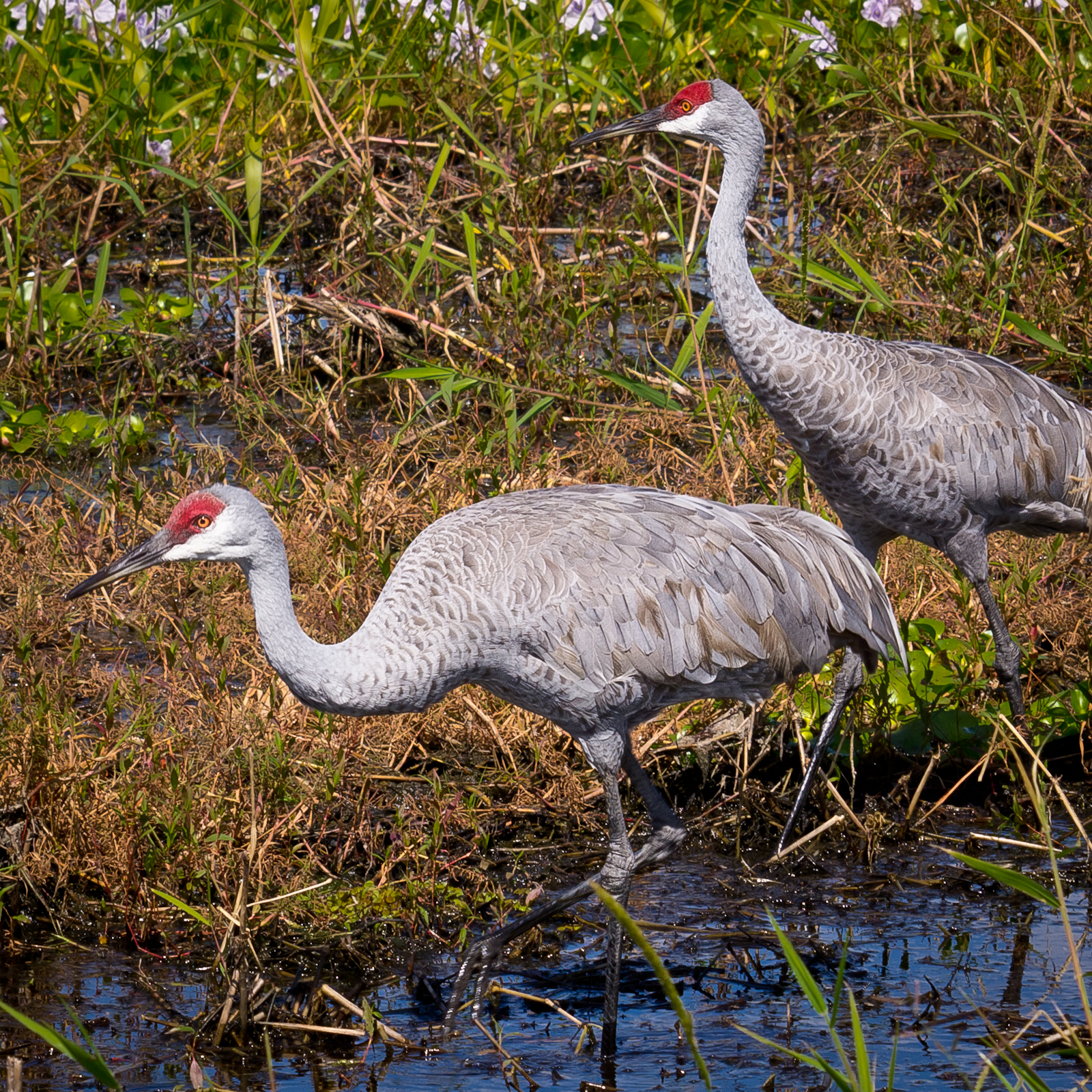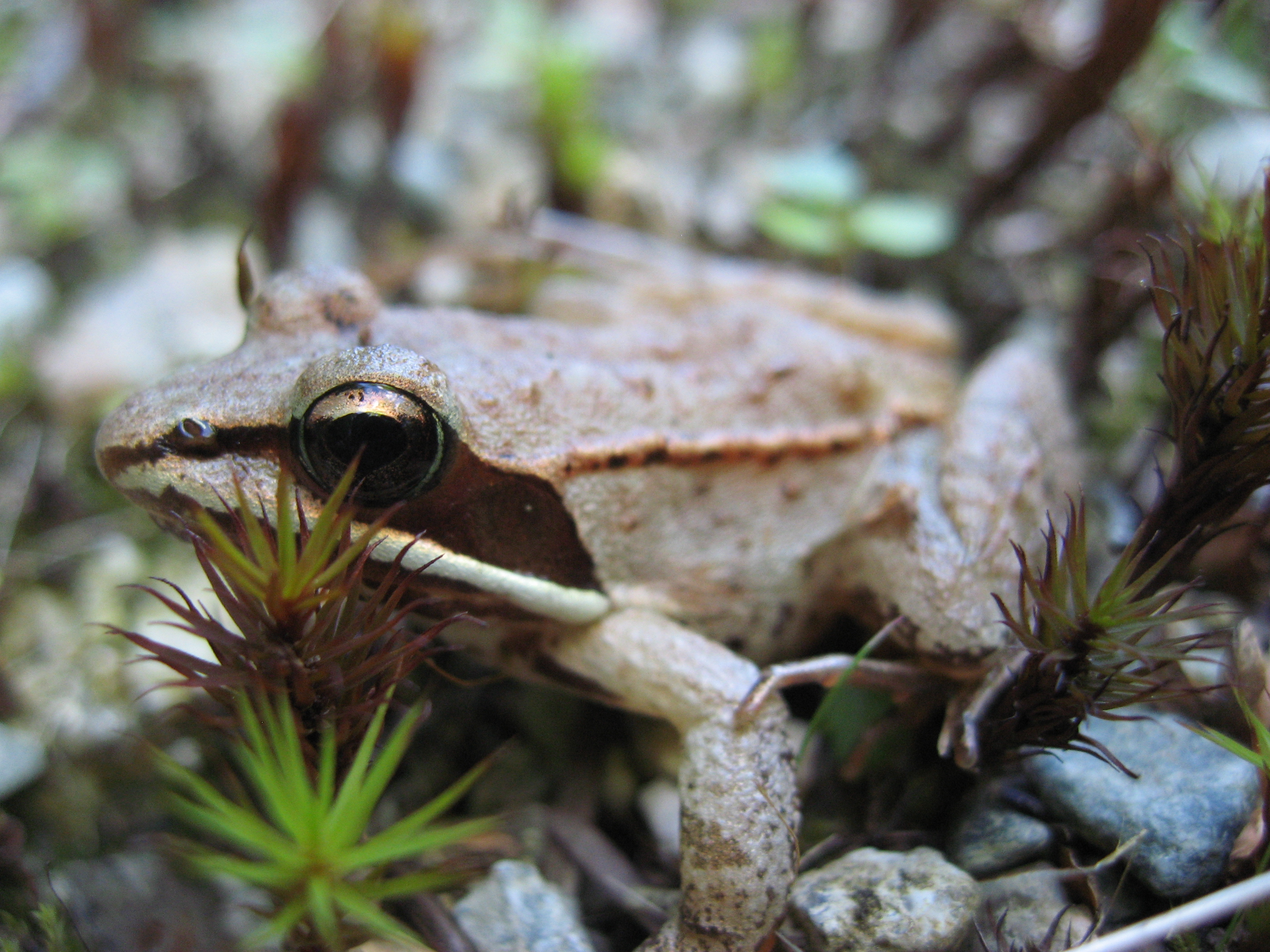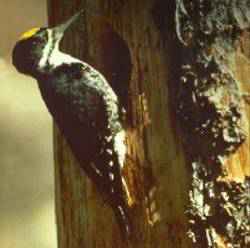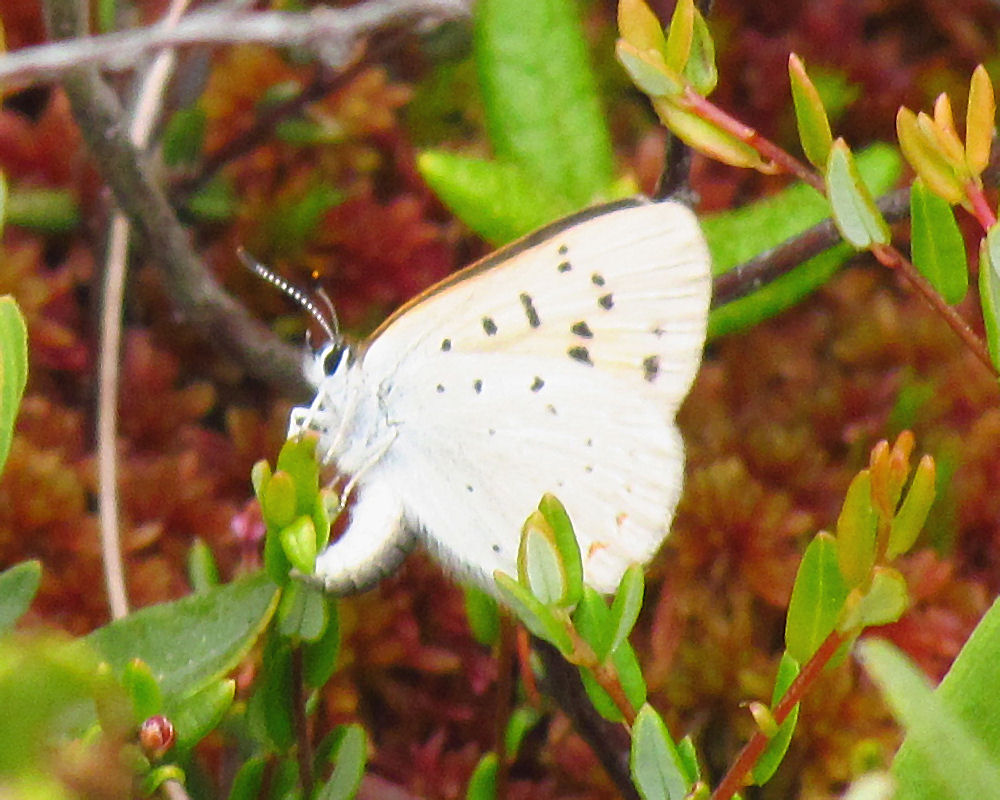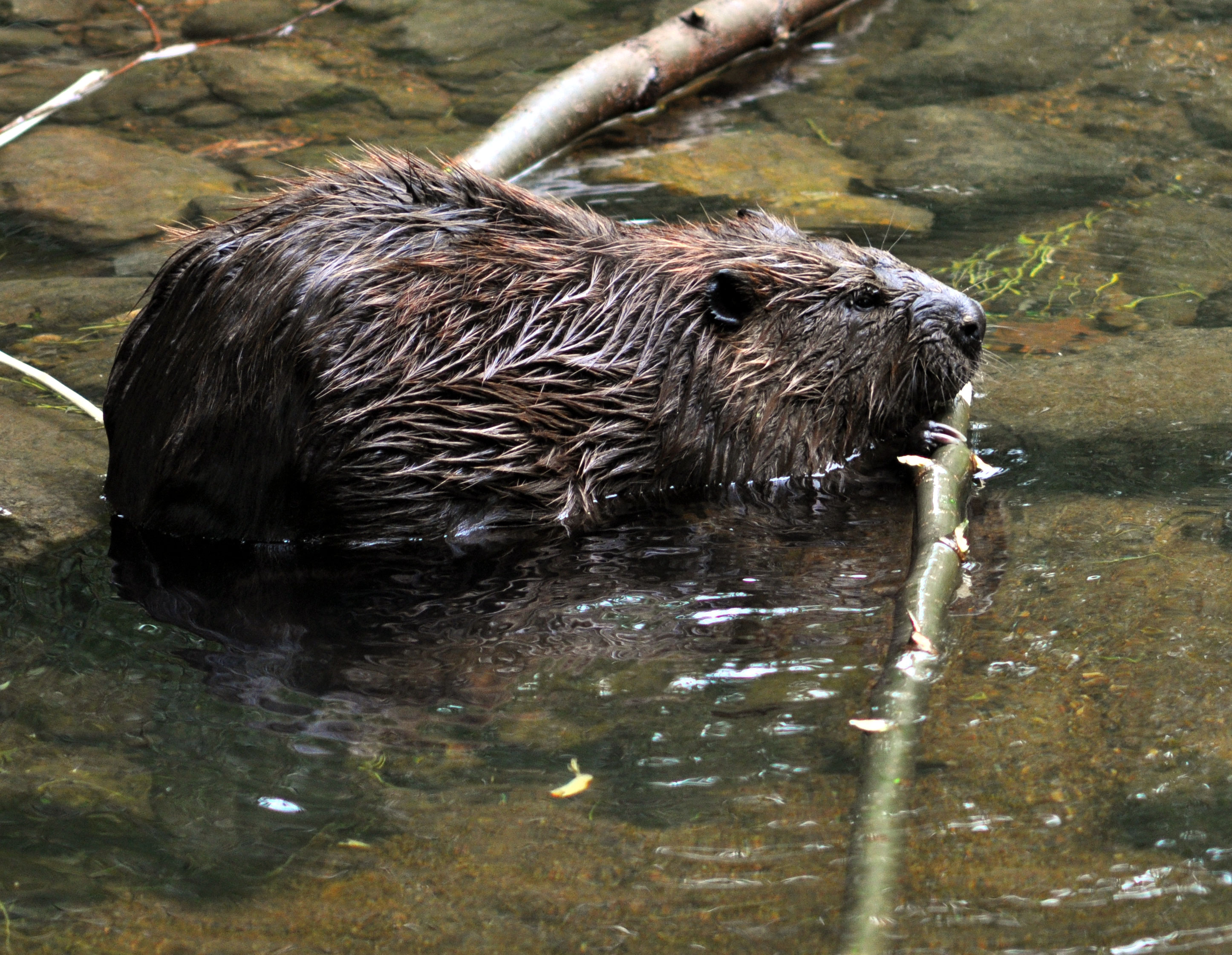Difference between revisions of "AY Honors/Bogs & Fens/Answer Key"
m (no insignia image yet) |
m (- Category of AYHAB) |
||
| (45 intermediate revisions by 4 users not shown) | |||
| Line 1: | Line 1: | ||
| − | {{honor | + | {{HonorSubpage}} |
| + | <!--{{Honor_Master|honor=Bogs & Fens|master=Conservation}}--> | ||
| + | <section begin="Body" /> | ||
| + | {{ansreq|page={{#titleparts:{{PAGENAME}}|2|1}}|num=1}} | ||
| + | <noinclude><translate><!--T:35--> | ||
| + | </noinclude> | ||
| + | <!-- 1. What is a bog? How is it unique? --> | ||
| + | A bog is a wetland formed in cold climates from water obtained only from the atmosphere (rain and snow). There are no other sources of water such as springs, rivers or streams. Because of this bogs are low in mineral nutrients (nutrients are usually washed into a body of water by rivers and streams). A mat of specialized vegetation grows out over the water. As leaves and plants die and fall in the water, decomposition is very slow, which causes the accumulation of organic matter at the bottom called “peat.” Because of this, the water in a bog is acidic and low in oxygen. Methane gas is a by-product of decomposition and can be seen sometimes bubbling up. Species diversity is low due to the harsh environment. They are important for “storing” carbon. | ||
| + | <noinclude></translate></noinclude> | ||
| + | {{CloseReq}} <!-- 1 --> | ||
| + | {{ansreq|page={{#titleparts:{{PAGENAME}}|2|1}}|num=2}} | ||
| + | <noinclude><translate><!--T:36--> | ||
| + | </noinclude> | ||
| + | <!-- 2. Where are bogs found? --> | ||
| + | Bogs occur mostly in cold, heavily forested regions of the northern hemisphere north of the 45th parallel. This region is also called the Boreal Zone. | ||
| − | + | <!--T:37--> | |
| − | + | <noinclude></translate></noinclude> | |
| − | = | + | {{CloseReq}} <!-- 2 --> |
| − | + | {{ansreq|page={{#titleparts:{{PAGENAME}}|2|1}}|num=3}} | |
| − | + | <noinclude><translate><!--T:38--> | |
| − | + | </noinclude> | |
| + | <!-- 3. Name 6 things that are needed for bog formation. --> | ||
# A basin with no drainage. | # A basin with no drainage. | ||
| − | # | + | # Rain and Snow are the only sources of water. |
| − | # | + | # Cool to cold climates. |
| − | # | + | # More precipitation than evaporation, saturated conditions. |
| − | # | + | # Reduced rate of decomposition resulting in peat formation |
| − | # | + | # Specific and amazing plant adaptations |
| − | ==4. Name and describe three different types of true bogs. | + | <noinclude></translate></noinclude> |
| − | ;Blanket Bog or Blanket Mire: | + | {{CloseReq}} <!-- 3 --> |
| + | {{ansreq|page={{#titleparts:{{PAGENAME}}|2|1}}|num=4}} | ||
| + | <noinclude><translate><!--T:39--> | ||
| + | </noinclude> | ||
| + | <!-- 4. Name and describe three different types of true bogs. --> | ||
| + | [[File:Blanket_bog.png|thumb|500px|Blanket bog]] | ||
| + | ;Blanket Bog or Blanket Mire: This type of bog has extensive peat cover not just covering basin filled with water, but these ‘blankets’ extend past the basin boundaries and cover the ground over large areas including hilltops, slopes and plateaus. Two hundred days of rainfall a year are needed to form these bogs. | ||
| + | {{clear}} | ||
| + | <!--T:4--> | ||
| + | [[File:Quaking_bog.png|thumb|500px|Quaking bog]] | ||
| + | ;Quaking bog: This type of bog has floating mats of vegetation including, mosses, shrubs and trees. The whole mat shakes when stepped on. Larger movements may cause trees to sway. | ||
| + | {{clear}} | ||
| − | |||
| + | <!--T:5--> | ||
| + | [[File:Raised_bog.png|thumb|500px|Raised bog]] | ||
| + | ;Raised Bog: A type of bog in which peat deposits grow above the water level forming domes or ‘raised’ mounds. These mounds may be surrounded by water forming islands. These are sometimes referred to as a Pocosin in the east. | ||
| + | {{clear}} | ||
| − | + | <!--T:40--> | |
| − | + | <noinclude></translate></noinclude> | |
| − | ==5. | + | {{CloseReq}} <!-- 4 --> |
| − | Bogs and Fens are both sources of peat and have a floating mat of vegetation. | + | {{ansreq|page={{#titleparts:{{PAGENAME}}|2|1}}|num=5}} |
| + | <noinclude><translate><!--T:41--> | ||
| + | </noinclude> | ||
| + | <!-- 5. What is the difference between a bog and fen? What is succession and how do bogs and fens illustrate this process? --> | ||
| + | [[File:Bog succession 1.png|thumb|500px|right]] | ||
| + | [[File:Bog succession 2.png|thumb|500px|right]] | ||
| + | [[File:Bog succession 3.png|thumb|500px|right]] | ||
| + | [[File:Bog succession 4.png|thumb|500px|right]] | ||
| + | Bogs and Fens are both sources of peat and have a floating mat of vegetation. The major difference has to do with the water source. Bogs are closed systems that have no connection to groundwater sources, Fens are open systems that depend on a groundwater source (springs). Fens are less acidic, have more nutrients and support a more diverse community of plants and animals. For a fen, the mat of vegetation is composed of herbs and grasses such as Tussock Grass. | ||
| − | + | <!--T:7--> | |
| − | Succession is where one community naturally changes over time eventually being replaced by a different community. | + | Succession is where one community naturally changes over time eventually being replaced by a different community. Fens and bogs are often found close together and over time, most fens become bogs. Peat builds up and separates the fen from its groundwater supply causing a closed system to form; nutrient levels drop, acidity increases and a bog is formed. Succession of bogs leads to the formation of conifer forests. |
{{clear}} | {{clear}} | ||
| − | ==6. | + | <!--T:42--> |
| − | * Exposed leaves are covered in waxy material, have thick woolly hair-like fibers, or hide their pores in deep pits on the underside to conserve nutrients and to reduce toxins such as iron and manganese. | + | <noinclude></translate></noinclude> |
| + | {{CloseReq}} <!-- 5 --> | ||
| + | {{ansreq|page={{#titleparts:{{PAGENAME}}|2|1}}|num=6}} | ||
| + | <noinclude><translate><!--T:43--> | ||
| + | </noinclude> | ||
| + | <!-- 6. What are some adaptations of bog plants? --> | ||
| + | * Exposed leaves are covered in waxy material, have thick woolly hair-like fibers, or hide their pores in deep pits on the underside to conserve nutrients and to reduce toxins such as iron and manganese. | ||
* Grow low to the ground or have slow stunted growth. | * Grow low to the ground or have slow stunted growth. | ||
| − | * Survive dramatic temperature differences. | + | * Survive dramatic temperature differences. |
* Live in acid conditions with low nutrients. | * Live in acid conditions with low nutrients. | ||
| − | ==7. What is Sphagnum Moss and how is it vital to bogs? | + | <!--T:44--> |
| − | Sphagnum Moss or Peat Moss (Family Sphagnaceae) is a plant that shapes and drives bog chemistry. | + | <noinclude></translate></noinclude> |
| − | + | {{CloseReq}} <!-- 6 --> | |
| − | + | {{ansreq|page={{#titleparts:{{PAGENAME}}|2|1}}|num=7}} | |
| − | + | <noinclude><translate><!--T:45--> | |
| − | + | </noinclude> | |
| + | <!-- 7. What is Sphagnum Moss and how is it vital to bogs? --> | ||
| + | [[File:Sphagnum.flexuosum.jpg|thumb|250px|''Sphagnum flexuosum'']] | ||
| + | Sphagnum Moss or Peat Moss (Family Sphagnaceae) is a plant that shapes and drives bog chemistry. It has gas-filled cells that help it to float and has amazing absorption properties enabling it to hold many times its own weight in water. It grows from the top and dies just a small distance down the stem. It slowly grows out from shore eventually forming a floating mat of vegetation over any open water resulting in the sun not being able to warm the water below. When new moss forms, the old moss is pushed underwater and decays very slowly into peat. As it slowly decays, tannin and acids are released killing bacteria and removing dissolved oxygen that would otherwise cause decomposition to occur, also turning the water brown. Dead peat moss accumulates until it is many feet deep and eventually, given enough time, will reach ground level below and fill the bog completely. Sphagnum Moss supports a variety of acid loving plants, shrubs and even trees to grow on top of its floating mass over deep water, also called bog forest. When stepped on, the mats shake, tilt and ripple causing even trees to sway. Falling into a bog can be dangerous so it is best to stay on designated boardwalks and trails. | ||
| − | === | + | <!--T:46--> |
| − | + | <noinclude></translate></noinclude> | |
| + | {{CloseReq}} <!-- 7 --> | ||
| + | {{ansreq|page={{#titleparts:{{PAGENAME}}|2|1}}|num=8}} | ||
| + | <noinclude><translate></noinclude> | ||
| + | <!-- 8. What are carnivorous plants and what makes them bog specific? Name and describe at least two of them. --> | ||
| + | Carnivorous plants trap animal prey (insects) to make up for the loss of nutrients they cannot obtain from the environment. The traps are modified leaves and may be “active” or “passive” depending on how they catch their prey. | ||
| + | ===Pitcher Plant (Passive)=== <!--T:47--> | ||
| + | [[File:Pitcher_Plant_at_Mississippi_Sandhill_Crane_NWR_(5327602495).jpg|thumb|Pitcher Plant at Mississippi Sandhill Crane National Wildlife Refuge]] | ||
| + | These plants form a slippery, colorful cupped leaf, and have a nectar-covered lip to lure insects. When an insect slips and falls in, it is trapped by downward pointing, sharp hairs. It is slowly dissolved in the liquid in the bottom of the cup. There are some insects that thrive in the pitcher plants by having an anti-enzyme that prevents them from being digested by the plant. | ||
| + | {{clear}} | ||
| − | === | + | ===Sundew (Active)=== <!--T:11--> |
| − | + | [[File:Sundew.jpg|thumb|Sundew]] | |
| − | + | Sticky hairs in their leaves attract and hold the insect, and then more sticky hairs fold over it until the insect is trapped and is digested. | |
| + | {{clear}} | ||
| − | {{ | + | ===Bladderwort (Active)=== <!--T:12--> |
| + | [[File:UtriculariaVulgarisFlowering.jpg|thumb|Common Bladderwort]] | ||
| + | A group of aquatic flowering plants that grow with no roots. They obtain their nutrition from the water or prey captured in small “bladders”. There are trigger hairs that, when touched, open a trap door and the prey is sucked in when the water rushes in to fill the “bladder” and the door shuts trapping the prey. | ||
| + | {{clear}} | ||
| − | + | <!--T:48--> | |
| − | + | <noinclude></translate></noinclude> | |
| + | {{CloseReq}} <!-- 8 --> | ||
| + | {{ansreq|page={{#titleparts:{{PAGENAME}}|2|1}}|num=9}} | ||
| + | <noinclude><translate><!--T:49--> | ||
| + | </noinclude> | ||
| + | <!-- 9. Name and describe five other plants or trees, which are found in bogs. --> | ||
| + | {{:AY Honors/Species Account/Larix laricina}} | ||
| + | <!--T:14--> | ||
| + | {{:AY Honors/Species Account/Vaccinium macrocarpon}} | ||
| − | + | <!--T:15--> | |
| − | + | {{:AY Honors/Species Account/Chamaedaphne calyculata}} | |
| − | + | <!--T:16--> | |
| − | + | {{:AY Honors/Species Account/Cypripedium acaule}} | |
| + | <!--T:17--> | ||
| + | {{:AY Honors/Species Account/Picea mariana}} | ||
| − | + | <!--T:18--> | |
| − | + | {{:AY Honors/Species Account/Rhododendron groenlandicum}} | |
| − | |||
| − | + | <!--T:50--> | |
| − | + | <noinclude></translate></noinclude> | |
| + | {{CloseReq}} <!-- 9 --> | ||
| + | {{ansreq|page={{#titleparts:{{PAGENAME}}|2|1}}|num=10}} | ||
| + | <noinclude><translate><!--T:51--> | ||
| + | </noinclude> | ||
| + | <!-- 10. Name and describe 5 animals that can be found in bogs and fens. --> | ||
| − | + | <!--T:20--> | |
| − | + | {{:AY Honors/Species Account/Grus Canadensis}} | |
| + | <!--T:21--> | ||
| + | {{:AY Honors/Species Account/Lithobates sylvaticus}} | ||
| + | <!--T:22--> | ||
| + | {{:AY Honors/Species Account/Picoides arcticus}} | ||
| + | <!--T:23--> | ||
| + | {{:AY Honors/Species Account/Alces alces}} | ||
| + | |||
| + | {{:AY Honors/Species Account/Lycaena epixanthe}} | ||
| + | <!--T:24--> | ||
| + | {{:AY Honors/Species Account/Synaptomys spp}} | ||
| + | |||
| + | {{:AY Honors/Species Account/Castor canadensis}} | ||
| + | <!--T:52--> | ||
| + | <noinclude></translate></noinclude> | ||
| + | {{CloseReq}} <!-- 10 --> | ||
| + | {{ansreq|page={{#titleparts:{{PAGENAME}}|2|1}}|num=11}} | ||
| + | <noinclude><translate><!--T:53--> | ||
| + | </noinclude> | ||
| + | <!-- 11. Tell a story about bogs and draw a spiritual lesson. --> | ||
| + | This is one example. You can develop your own story. | ||
| − | + | <!--T:26--> | |
| − | + | “And do not be conformed to this world, but be transformed by the renewing of your mind, that you may prove what is that good and acceptable and perfect will of God.” Romans 12:2 | |
| + | Pitcher plants (Family Sarraceniaceae) are carnivorous plants, meaning they have unique ways of catching insect prey and digesting them to obtain nutrients otherwise not available in their environment. The plant has large "pitcher" shaped leaves that catch rain water. The "lip" of the leaf is pretty colored, fragrant and slippery. Insects are attracted to this, fall in and are trapped, unable to escape due to sharp, down pointing hairs causing the insect to drown. The plant then digests its catch. This family of plants (nine species here in North America) often inhabit peatlands, bogs, pine barrens and other such habitats that are hostile to most other types of plants. In one species, the leaves can grow to be almost 3 feet tall! Strangely enough, some insects and other small creatures survive and even thrive inside the pitcher plant. They may spend some time there and move on or in some cases, make a permanent home. There is a type of mosquito larvae (Pitcher Plant Mosquito – Wyeomyia smithii ) that lives in the very fluid that consumes other types of insects. This mosquito living in the pitcher plants have special anti-enzymes that prevent them from being digested. The Bible is like these anti-enzymes; we must have God's word as part of our whole being, our lifestyle and full commitment. We live in a crazy, scary world yet we are not part of this world. We are only passing through. We are not to be consumed by the things and desires this world has to offer for they result in death, just like insects that fall into the pitcher plant and are digested because they do not have the anti-enzyme. God's word must be written in our hearts and minds. May we encourage each other to become filled with these spiritual "anti-enzymes". (Beckermeyer) (Johnson & Worley, 1985) | ||
| − | + | <!--T:54--> | |
| − | + | <noinclude></translate></noinclude> | |
| + | {{CloseReq}} <!-- 11 --> | ||
| + | {{ansreq|page={{#titleparts:{{PAGENAME}}|2|1}}|num=12}} | ||
| + | <noinclude><translate><!--T:55--> | ||
| + | </noinclude> | ||
| + | <!-- 12. Do at least 2 of the following activities: --> | ||
| + | <!--T:56--> | ||
| + | <noinclude></translate></noinclude> | ||
| + | {{ansreq|page={{#titleparts:{{PAGENAME}}|2|1}}|num=12a}} | ||
| + | <noinclude><translate><!--T:57--> | ||
| + | </noinclude> | ||
| − | + | <!--T:58--> | |
| − | + | <noinclude></translate></noinclude> | |
| − | + | {{CloseReq}} <!-- 12a --> | |
| − | + | {{ansreq|page={{#titleparts:{{PAGENAME}}|2|1}}|num=12b}} | |
| − | + | <noinclude><translate><!--T:59--> | |
| − | + | </noinclude> | |
| − | + | {{AY Honors/Zoo Visit}} | |
| − | |||
| − | |||
| − | |||
| − | |||
| − | |||
| − | |||
| − | |||
| − | |||
| − | |||
| − | |||
| − | |||
| − | |||
| − | |||
| − | |||
| − | |||
| + | <!--T:60--> | ||
| + | <noinclude></translate></noinclude> | ||
| + | {{CloseReq}} <!-- 12b --> | ||
| + | {{ansreq|page={{#titleparts:{{PAGENAME}}|2|1}}|num=12c}} <!--T:28--> | ||
| + | <noinclude><translate><!--T:61--> | ||
| + | </noinclude> | ||
| + | Here is one possibility. <span class="noprint">If you find others, please add them here!</span> | ||
| + | <!--T:29--> | ||
| + | {{#widget:YouTube|id=UyscwDzcMXE}} | ||
| + | {{#widget:YouTube|id=KPmT48SG4DU}} | ||
| + | {{clear}} | ||
| − | + | <!--T:30--> | |
| − | + | Here is another: | |
| + | *[http://video.pbs.org/video/2183155127/ Bog Restored in New Jersey Nature Preserve] PBS, 2m:17s | ||
| − | + | <!--T:62--> | |
| − | + | <noinclude></translate></noinclude> | |
| + | {{CloseReq}} <!-- 12c --> | ||
| + | {{ansreq|page={{#titleparts:{{PAGENAME}}|2|1}}|num=12d}} <!--T:31--> | ||
| + | <noinclude><translate><!--T:63--> | ||
| + | </noinclude> | ||
| + | You can either create your picture during your visit to a bog or fen, or you can take a picture and work from that when you get back. See the [[AY Honors/Drawing|Drawing]] and [[AY Honors/Painting|Painting]] honors for tips on creating your artwork. | ||
| − | + | <!--T:64--> | |
| − | + | <noinclude></translate></noinclude> | |
| − | == | + | {{CloseReq}} <!-- 12d --> |
| − | + | {{ansreq|page={{#titleparts:{{PAGENAME}}|2|1}}|num=12e}} <!--T:32--> | |
| − | + | <noinclude><translate><!--T:65--> | |
| − | + | </noinclude> | |
| + | See the [[AY Honors/Video|Video]] honor for instruction on making your video, and be sure to check out the [[AY Honors/Environmental Conservation|Environmental Conservation]] and [[AY Honors/Endangered Species|Endangered Species]] honors while you're researching this option. | ||
| − | ==References== | + | <!--T:66--> |
| + | <noinclude></translate></noinclude> | ||
| + | {{CloseReq}} <!-- 12e --> | ||
| + | {{CloseReq}} <!-- 12 --> | ||
| + | <noinclude><translate></noinclude> | ||
| + | ==References== <!--T:33--> | ||
*Benyus, J. M. (1989). Northwoods Wildlife, A Watcher's Guide to Habitats. Minocqua, WI: Northwood Press. | *Benyus, J. M. (1989). Northwoods Wildlife, A Watcher's Guide to Habitats. Minocqua, WI: Northwood Press. | ||
*Brock, J. P., & Kauffman, K. (2003). Butterflies of North America. New York, New York: Hillstar Editions, L.C and Houghton Mifflin Company. | *Brock, J. P., & Kauffman, K. (2003). Butterflies of North America. New York, New York: Hillstar Editions, L.C and Houghton Mifflin Company. | ||
| Line 138: | Line 250: | ||
*Niering, W. A. (1989). The Audubo Society Nature Guides, Wetlands. New York: Alfred A. Knopf, Inc. and Random House, Inc. | *Niering, W. A. (1989). The Audubo Society Nature Guides, Wetlands. New York: Alfred A. Knopf, Inc. and Random House, Inc. | ||
*Root, P., & Bowen, B. (2010). Big Belching Bog. Minneapolis, Minnesota: University of Minnesota Press. | *Root, P., & Bowen, B. (2010). Big Belching Bog. Minneapolis, Minnesota: University of Minnesota Press. | ||
| + | <noinclude></translate></noinclude> | ||
| + | {{CloseHonorPage}} | ||
Latest revision as of 21:55, 14 July 2022
1
A bog is a wetland formed in cold climates from water obtained only from the atmosphere (rain and snow). There are no other sources of water such as springs, rivers or streams. Because of this bogs are low in mineral nutrients (nutrients are usually washed into a body of water by rivers and streams). A mat of specialized vegetation grows out over the water. As leaves and plants die and fall in the water, decomposition is very slow, which causes the accumulation of organic matter at the bottom called “peat.” Because of this, the water in a bog is acidic and low in oxygen. Methane gas is a by-product of decomposition and can be seen sometimes bubbling up. Species diversity is low due to the harsh environment. They are important for “storing” carbon.
2
Bogs occur mostly in cold, heavily forested regions of the northern hemisphere north of the 45th parallel. This region is also called the Boreal Zone.
3
- A basin with no drainage.
- Rain and Snow are the only sources of water.
- Cool to cold climates.
- More precipitation than evaporation, saturated conditions.
- Reduced rate of decomposition resulting in peat formation
- Specific and amazing plant adaptations
4
- Blanket Bog or Blanket Mire
- This type of bog has extensive peat cover not just covering basin filled with water, but these ‘blankets’ extend past the basin boundaries and cover the ground over large areas including hilltops, slopes and plateaus. Two hundred days of rainfall a year are needed to form these bogs.
- Quaking bog
- This type of bog has floating mats of vegetation including, mosses, shrubs and trees. The whole mat shakes when stepped on. Larger movements may cause trees to sway.
- Raised Bog
- A type of bog in which peat deposits grow above the water level forming domes or ‘raised’ mounds. These mounds may be surrounded by water forming islands. These are sometimes referred to as a Pocosin in the east.
5
Bogs and Fens are both sources of peat and have a floating mat of vegetation. The major difference has to do with the water source. Bogs are closed systems that have no connection to groundwater sources, Fens are open systems that depend on a groundwater source (springs). Fens are less acidic, have more nutrients and support a more diverse community of plants and animals. For a fen, the mat of vegetation is composed of herbs and grasses such as Tussock Grass.
Succession is where one community naturally changes over time eventually being replaced by a different community. Fens and bogs are often found close together and over time, most fens become bogs. Peat builds up and separates the fen from its groundwater supply causing a closed system to form; nutrient levels drop, acidity increases and a bog is formed. Succession of bogs leads to the formation of conifer forests.
6
- Exposed leaves are covered in waxy material, have thick woolly hair-like fibers, or hide their pores in deep pits on the underside to conserve nutrients and to reduce toxins such as iron and manganese.
- Grow low to the ground or have slow stunted growth.
- Survive dramatic temperature differences.
- Live in acid conditions with low nutrients.
7
Sphagnum Moss or Peat Moss (Family Sphagnaceae) is a plant that shapes and drives bog chemistry. It has gas-filled cells that help it to float and has amazing absorption properties enabling it to hold many times its own weight in water. It grows from the top and dies just a small distance down the stem. It slowly grows out from shore eventually forming a floating mat of vegetation over any open water resulting in the sun not being able to warm the water below. When new moss forms, the old moss is pushed underwater and decays very slowly into peat. As it slowly decays, tannin and acids are released killing bacteria and removing dissolved oxygen that would otherwise cause decomposition to occur, also turning the water brown. Dead peat moss accumulates until it is many feet deep and eventually, given enough time, will reach ground level below and fill the bog completely. Sphagnum Moss supports a variety of acid loving plants, shrubs and even trees to grow on top of its floating mass over deep water, also called bog forest. When stepped on, the mats shake, tilt and ripple causing even trees to sway. Falling into a bog can be dangerous so it is best to stay on designated boardwalks and trails.
8
Carnivorous plants trap animal prey (insects) to make up for the loss of nutrients they cannot obtain from the environment. The traps are modified leaves and may be “active” or “passive” depending on how they catch their prey.
Pitcher Plant (Passive)
These plants form a slippery, colorful cupped leaf, and have a nectar-covered lip to lure insects. When an insect slips and falls in, it is trapped by downward pointing, sharp hairs. It is slowly dissolved in the liquid in the bottom of the cup. There are some insects that thrive in the pitcher plants by having an anti-enzyme that prevents them from being digested by the plant.
Sundew (Active)
Sticky hairs in their leaves attract and hold the insect, and then more sticky hairs fold over it until the insect is trapped and is digested.
Bladderwort (Active)
A group of aquatic flowering plants that grow with no roots. They obtain their nutrition from the water or prey captured in small “bladders”. There are trigger hairs that, when touched, open a trap door and the prey is sucked in when the water rushes in to fill the “bladder” and the door shuts trapping the prey.
9
Tamarack (Larix laricina)
Description: This tree is very cold-tolerant conifer that loses its needles in the fall, and grows new ones in the spring. They need open sunlight, can survive in a wide range of soils including the low nutrient acidic soil of bogs.
Cranberry (Vaccinium macrocarpon)
Description: This shrub grows best in very acidic environments. Many species of insects eat, live off and reproduce on cranberry bushes. Cranberries are grown commercially in man-made bogs.
Leatherleaf (Chamaedaphne calyculata)
Description: A flowering shrub that keeps its old leaves until the new leaves are well grown. The stomata or breathing pores are sparse and deep in pits. The leaves feel leathery and are brown underneath.
Pink Lady Slipper (Cypripedium acaule)
Description: Also known as a stemless lady's slipper or moccasin flower, it needs acidic soil and a special fungus in the soil (wet or dry) to help it absorb nutrients. This species is common in parts of the northern United States and adjoining provinces of Canada, but it is considered endangered in Illinois and Tennessee, vulnerable in New York, and unusual in Georgia.
Black Spruce (Picea mariana)
Description: This tree has a horizontal, shallow root system. As the tree grows in a bog, it sinks slowly. It sends off new shoots from the buried trunk and branches. These new shoots form a ring of new young trees around the parent tree. Eventually the parent tree dies, usually from sinking deep enough that it drowns.
Labrador Tea (Rhododendron groenlandicum)
Description: This bog-specific shrub was formerly known as Ledum groenlandicum. the evergreen leaves are smooth on top, woolly underneath and have rolled margins. The dense hairy twigs and sticky white flowers attract huge numbers of insects.
10
Sandhill Crane (Grus Canadensis)
Description: This bird has a seven-foot wingspan and depends on peatlands for breeding and nesting sites. It migrates annually.
Wood Frog (Lithobates sylvaticus)
Description: This is the only frog found north of the Arctic Circle and is primarily terrestrial. They have an explosive breeding cycle, which means that all frogs head to the water and breed all at once in 1-2 days. They hibernate for the winter in dead logs, under piles of leaf matter or shallow burrows. They are freeze-tolerant; meaning their heart and breathing actually stop, and much of their body tissues freeze. When warmer weather come, the breathing and heart resume functioning and the frog wakes up from hibernation.
Black-backed Woodpecker (Picoides arcticus)
Description: This bird lives year round in and near peatlands. Its primary food are wood boring grubs of dead conifers especially Black Spruce.
Moose (Alces alces)
Description: This large mammal and plant eater has long legs and wide feet for wandering in swamps, bogs and fens. It is very capable of wading and browsing in deep water, mud and muck for vegetation to eat. It often chooses to stand in deep water to stay cool and to avoid blackflies and mosquitoes.
Bog Copper Butterfly (Lycaena epixanthe)
Description: Adult Bog Copper Butterflies like to sip drops of dew clinging to leaves and almost exclusively nectar on their host plant, cranberries. Because of this, Bog Coppers will spend their entire lives within the area of a single acid bog.
Bog Lemming (Synaptomys spp.)
Description: Bog lemmings are small rodents that are not true lemmings, but are more similar to voles. They like sphagnum bogs, swamps and forest meadows. They live in colonies, dig burrows and tunnels about 6 inches below the surface. The nests are connected by “highways” with multiple entrances. There are two extant species in the genus, the Northern Bog Lemming (S. borealis) and the Southern Bog Lemming (S. cooperi, shown).
Beaver (Castor canadensis)
Description: This is a very large brown rodent, with a flat tail, and large webbed feet. They chew trees down to build large dams and lodges and for food (bark). Beavers can change the environment by causing water to back up where it was not before or cut off water supplies all together. This can lead to the formation of a bog or fen and cause the downstream to slow or stop all together.
11
This is one example. You can develop your own story.
“And do not be conformed to this world, but be transformed by the renewing of your mind, that you may prove what is that good and acceptable and perfect will of God.” Romans 12:2 Pitcher plants (Family Sarraceniaceae) are carnivorous plants, meaning they have unique ways of catching insect prey and digesting them to obtain nutrients otherwise not available in their environment. The plant has large "pitcher" shaped leaves that catch rain water. The "lip" of the leaf is pretty colored, fragrant and slippery. Insects are attracted to this, fall in and are trapped, unable to escape due to sharp, down pointing hairs causing the insect to drown. The plant then digests its catch. This family of plants (nine species here in North America) often inhabit peatlands, bogs, pine barrens and other such habitats that are hostile to most other types of plants. In one species, the leaves can grow to be almost 3 feet tall! Strangely enough, some insects and other small creatures survive and even thrive inside the pitcher plant. They may spend some time there and move on or in some cases, make a permanent home. There is a type of mosquito larvae (Pitcher Plant Mosquito – Wyeomyia smithii ) that lives in the very fluid that consumes other types of insects. This mosquito living in the pitcher plants have special anti-enzymes that prevent them from being digested. The Bible is like these anti-enzymes; we must have God's word as part of our whole being, our lifestyle and full commitment. We live in a crazy, scary world yet we are not part of this world. We are only passing through. We are not to be consumed by the things and desires this world has to offer for they result in death, just like insects that fall into the pitcher plant and are digested because they do not have the anti-enzyme. God's word must be written in our hearts and minds. May we encourage each other to become filled with these spiritual "anti-enzymes". (Beckermeyer) (Johnson & Worley, 1985)
12
12a
12b
If you are planning to visit a zoo or aquarium, be aware that there are various honors that have requirements which can be met by visiting a zoo or aquarium. Individuals can work on multiple honors in one visit, or parts of your group may work on different honors during the same visit.
Here is a list of honors which have requirements that can be met by visiting a zoo or aquarium:
12c
12d
You can either create your picture during your visit to a bog or fen, or you can take a picture and work from that when you get back. See the Drawing and Painting honors for tips on creating your artwork.
12e
See the Video honor for instruction on making your video, and be sure to check out the Environmental Conservation and Endangered Species honors while you're researching this option.
References
- Benyus, J. M. (1989). Northwoods Wildlife, A Watcher's Guide to Habitats. Minocqua, WI: Northwood Press.
- Brock, J. P., & Kauffman, K. (2003). Butterflies of North America. New York, New York: Hillstar Editions, L.C and Houghton Mifflin Company.
- Campbell, S., Hunt, A., Kerridge, R., Lynch, T., & Wohl, E. (2011). The Face of the Earth; Natural Landscapes, Science and Culture. Berkeley and Los Angeles, California: University of California Press.
- Eastman, J. (1995). The Book of Swamp and Bog. Mechanicsburg, Pennsylvannia: Stackpole Books.
- EcoRiskProfile. (n.d.). Retrieved from www.epa.gov: http://www.epa.gov/region1/ge/thesite/restofriver/reports/final_era/B%20-%20Focus%20Species%20Profiles/EcoRiskProfile_wood_frog.pdf
- Graham, L. E., Graham, J. M., & Wilcox, L. W. (2003). Plant Biology. In Plant Biology. Upper Saddle River, New Jersey: Pearson Education, Inc.
- Haslam, S. M. (2003). Understanding Wetlands. New York, New York: Taylor and Francis.
- Johnson, C. W., & Worley, I. A. (1985). Bogs Of The Northeast. Hanover, New Hampshire: University Press of New England.
- Larsen, J. A. (1982). Ecology of the Northern Lowland Bogs and Conifer Forests. New York, New York: Academic Press, Inc.
- Milne, L. J., & Milne, M. (1984). The Mystery of the Bog Forest. Toronto, Canada: McClelland and Stewart Limited.
- Mitsch, W. J., & Gosselink, J. G. (1993). Wetlands: Second Edition. New York, New York: Van Nostrand Reinhold, International Thomson Publishing.
- Moore, P. D. (2008). Wetlands. New York, New York: Facts on File, Inc.
- Niering, W. A. (1989). The Audubo Society Nature Guides, Wetlands. New York: Alfred A. Knopf, Inc. and Random House, Inc.
- Root, P., & Bowen, B. (2010). Big Belching Bog. Minneapolis, Minnesota: University of Minnesota Press.
